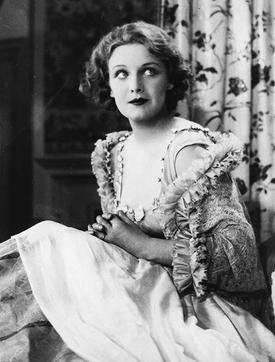Related Research Articles
The White Lilac is a 1935 British mystery film directed by Albert Parker and starring Basil Sydney, Judy Gunn, Claude Dampier and Percy Marmont. It is based upon the play of the same name by Ladislas Fodor. It was made at Wembley Studios as a quota quickie by the British subsidiary of Fox Film.
The Man Outside is a 1933 British crime film directed by George A. Cooper and starring Henry Kendall, Gillian Lind and Joan Gardner. It was shot at Twickenham Studios in London and features sets designed by the art director James A. Carter. Made as a quota quickie, it was distributed by RKO Pictures. It is unrelated to the play The Man Outside, which was not written until 1946.
Kiss Me Sergeant is a 1930 British comedy film directed by Monty Banks and starring Leslie Fuller, Gladys Cruickshank and Gladys Frazin. It was based on a play by Syd Courtenay and was sometimes released under the alternative title Idol of Moolah.
Lord of the Manor is a 1933 British comedy film directed by Henry Edwards and starring Betty Stockfeld, Frederick Kerr and Henry Wilcoxon. It was based on a play by John Hastings Turner. It was made at British and Dominion Elstree Studios as a quota film for release by Paramount Pictures.

The School for Scandal is a 1930 British historical comedy film directed by Thorold Dickinson and Maurice Elvey and starring Basil Gill, Madeleine Carroll and Ian Fleming. It is the first sound film adaptation of Richard Brinsley Sheridan's play The School for Scandal. It is also the only feature-length film shot using the unsuccessful Raycol colour process, and marked the screen debut of Sally Gray. The film was shot at the Elstree Studios of British International Pictures with sets designed by the art director Lawrence P. Williams. It ended up being released as a second feature and is classified as a quota quickie.
Should a Doctor Tell? is a 1930 British drama film directed by H. Manning Haynes and starring Basil Gill, Norah Baring and Maurice Evans. The screenplay concerns a doctor who agonises over whether to tell his son that the woman he is marrying is pregnant by another man, which would mean breaking the hypocratic oath.

A Shot in the Dark is a 1933 British mystery film directed by George Pearson and starring Dorothy Boyd, O. B. Clarence, Jack Hawkins and Michael Shepley. It was shot at Twickenham Studios in London as a quota quickie for release by RKO Pictures.
Chelsea Life is a 1933 British drama film directed by Sidney Morgan and starring Louis Hayward, Molly Johnson and Anna Lee. It was shot at Elstree Studios as a quota quickie for release by the British subsidiary of Paramount Pictures.
Not So Quiet on the Western Front is a 1930 British comedy film directed by Monty Banks and starring Leslie Fuller, Mona Goya and Wilfred Temple. It was made as a quota quickie by British International Pictures at Elstree Studios. Its title is a reference to All Quiet on the Western Front.
Meet My Sister is a 1933 British comedy film directed by Jean Daumery and starring Clifford Mollison, Constance Shotter and Enid Stamp-Taylor. It was made at Welwyn Studios as a quota quickie by British International Pictures.
Great Stuff is a 1933 British comedy film directed by Leslie S. Hiscott and starring Henry Kendall, Betty Astell and Alfred Wellesley. In the film, a woman's parents became robbers in a desperate effort to prevent her marrying an unsuitable man.
Matinee Idol is a 1933 British crime film directed by George King and starring Camilla Horn, Miles Mander and Marguerite Allan. The screenplay concerns a young actress who is suspected of murder. It was shot at Wembley Studios in London. The film's sets were designed by the art director J. Elder Wills. It was a quota quickie distributed by United Artists.
I'm an Explosive is a 1933 British comedy film directed by Adrian Brunel and starring William Hartnell, Gladys Jennings and Eliot Makeham. In the film, the son of an inventor is believed to have accidentally drunk an explosive liquid.
Brides to Be is a 1934 British comedy film directed by Reginald Denham and starring Betty Stockfeld, Constance Shotter and Ronald Ward. The film was made at Elstree Studios as a quota quickie for release by the British branch of Paramount Pictures.
The Black Mask is a 1935 British crime film directed by Ralph Ince and starring Wylie Watson, Aileen Marson and Ellis Irving. It was made at Teddington Studios as a quota quickie by Warner Bros.' British subsidiary. The film's sets were designed by the studio's resident art director Peter Proud. It is now considered a lost film.
Adventure Ltd. is a 1935 British adventure film directed by George King and starring Harry Milton, Pearl Argyle and Sebastian Shaw. It was made at Elstree Studios as a quota quickie for release by Paramount Pictures.
The Other Woman is a 1931 British drama film directed by G. B. Samuelson and starring Isobel Elsom, David Hawthorne and Eva Moore. It was made as a quota quickie.
Borrowed Clothes is a 1934 British drama film directed by Arthur Maude and starring Anne Grey, Lester Matthews and Sunday Wilshin.
A Glimpse of Paradise is a 1934 British crime film directed by Ralph Ince and starring George Carney, Eve Lister and Wally Patch.
The Unholy Quest is a 1934 British horror film directed by Widgey R. Newman and starring Claude Bailey, Terence de Marney and Christine Adrian. It was made as a quota quickie.
References
- ↑ Wood p.76